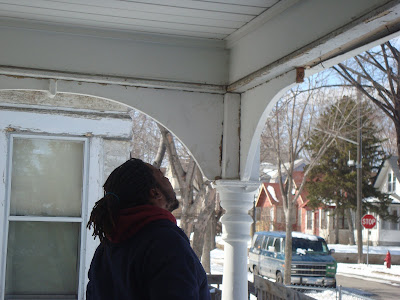Tuesday, April 19, 2011
Preserving Hawthorne Housing History
Post and photos by the Hawthorne Hawkman.
Last year, Twin Cities Habitat for Humanity purchased quite a few homes in Hawthorne to rehab or in some cases demolish and build new. Folks may have heard a little bit about that in the press, what with President Carter and Vice President Mondale working together in the Hawthorne EcoVillage. It was kind of a big deal. The story of 315 30th Ave N is a big deal too, but on a more personal level within Hawthorne.
Habitat bought this property with the intention of rehabbing the home, but through an odd sequence of events, both the vinyl siding and the paint underneath tested positive for lead. The abatement costs for lead removal just about doubled. That, combined with some foundation issues, led Habitat to the conclusion that they could build a longer-standing and less expensive house by demolishing and starting anew.
When that news spread, one of Hawthorne's newest residents came to the rescue of some of the features that still remained at the property. Brian Finstad just happened to be living in a house that was...
...built by the same architect that did 315 30th. As luck would have it, many of those trimmings were some of the few items missing from Brian's new home. You'd think that removing pieces from a home set for demolition (and doing so with permission) would be easy, but with federal regulations nothing ever is. We had to clear everything with Habitat so that 1) nobody was stealing anything, and 2) none of the work being done would happen in a way that was out of line with federal rules regarding lead abatement.
It helped that when Finstad brought his home up to code compliance, he became certified in lead paint removal. And it's also worth noting that with changes to the code compliance process general contractors are now a requirement. The code compliance process is difficult enough for the average person to navigate, but that change makes it virtually impossible that NoMi will get new neighbors in the same way that Brian came to our community.
So one Saturday afternoon this spring, several Hawthorne neighbors got permission from Habitat to remove the historic features at 315 30th Ave N. We couldn't save the house itself, but we did keep much of its history. Those items will be restored and used at a home built by the same architect in the same community. A little bit of our history is preserved, and through Habitat we get to welcome more new owners into Hawthorne later in the year.
Subscribe to:
Post Comments (Atom)





Thanks Jeff - one point of clarification is that these houses weren't designed by architects but rather had a similar builder (minor point). The other point that I think is interesting to note is that these original features that were missing on our house had been stolen by architectural theives during the time our house was foreclosed upon, vacant, and condemned. I am a huge believer in salvage whenever possible, but it is even more heart warming that not only did they stay in the same neighborhood, but also made right of a wrong that had been done.
ReplyDeleteBrian, you and Ray ROCK!
ReplyDeleteI will tell you again: you should get your own blog or become a guest author on another blog. You have so much to say and contribute, and a lot of it just goes into your articulate, expressive emails when what you are saying and doing deserves a wider audience.
How does one go about finding the architect of a house? I'm interested in finding who built my house. Thanks....
ReplyDelete@ Anonymous - Planning and Development Review downtown has original building permits that can be looked up on computers available to the general public. What I typically do is pull the original building permit to find the original owner, architect (if there is one), and builder. If you do find that your property was architect designed, contact Preserve Minneapolis and they will likely be able to point you in the direction of more information about the architect (or builder) of your home. If the architect and builder are one in the same, this is then known as a "Master Builder." In Minneapolis such examples would be T.P. Healy (best known), Henry Ingham, C.C. Johnson, or Henry Parsons (among others). Another tip is to take the name of the original owner and go to the Hennepin History Museum, look up the name in old city directories, and you will likely find out what they did for an occupation. Also at the HHM is the Confer Real Estate Photo Collection - if you're very lucky, they might even have a picture of your house! http://hennepinhistory.org/photographs.aspx
ReplyDeleteGreat post, thanks for sharing.
ReplyDelete